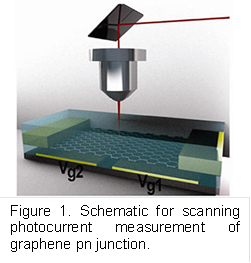57th Annual Report on Research 2012 Under Sponsorship of the ACS Petroleum Research Fund
Reports: DNI1051115-DNI10: Fundamental Investigation of Carrier Multiplication Processes in Carbon Nanomaterials
Zhaohui Zhong, PhD, University of Michigan
Progress Report:
The overall goal of the proposed project is to systematically study the fundamental exciton and carrier dynamics in carbon nanomaterials such as graphene. During the first year of the project, we built a scanning photocurrent measurement setup integrated with both continuous wave (CW) and femtosecond pulse laser as excitation sources. By careful examination of gate-dependent photocurrent excited by CW and pulse laser, we discovered direct evidence of nonequilibrium hot carrier extraction from graphene.
Our graphene pn junction device structure and the scanning photocurrent measurement setup are shown in Figure 1. A pair of split bottom gates (Vg1 and Vg2) can electrostatically dope the graphene in the above sections into p and n-type, respectively, and form the pn junction in between. The device can be excited by using either CW or femtosecond pulse laser. During a typical scanning photocurrent measruement, we raster scan the excitation laser across the device, and simultaneously measure the photocurrent and reflected light intensity. Fig. 2a and 2b show the extracted gate dependent photocurrent at the metal/graphene contact edge under CW and femtosecond pulse laser excitation, respectively. In Fig. 2a, the photocurrent excited by CW laser switches sign at Vg2 = 7.5 V, agreeing with the literature establishing that the work function difference between graphene and metal determines the sign of photocurrent. Based on the thickness of the gate dielectric (50 nm Al2O3, ε~7.5) and the Dirac point voltage, we estimate a metal work function of 4.3 eV, consistent with the typical value for our contact metal Ti. In comparison, surprisingly, photocurrent excited by the pulse laser (Fig. 2b) remains positive throughout the gate voltage sweep and peaks at Vg2 = 5 V, coincide with the Dirac point gate voltage. Furthermore, the photocurrent curve exhibits nearly symmetrical decay around Vg2 = 5 V by increasing either hole density or electron density.
The unusual photocurrent response from pulse laser excitation provides evidence for nonequilibrium hot carrier extraction from graphene. Photo-generated hot carriers typically release energy to optical phonons on a sub-picosecond time scale, followed by slower relaxation through scattering with acoustic phonons and electron-hole recombination. Under CW excitation, photocarriers will relax and accumulate near the equilibrium Fermi level (Fig. 2c), and photocurrent arises from the extraction of these near-equilibrium carriers by either electric field or local temperature gradient. However, the lack of photocurrent polarity reversal under pulsed excitation hints at a different mechanism. Under pulse illumination, a high flux of photon excitation will create a significant density of hot carriers. The relaxation of these hot carriers through scattering with optical phonons will quickly raise the optical phonon temperature to near the hot carrier temperature, which becomes the bottleneck for thermal relaxation of hot carriers. These processes lead to nonequilibrium hot carriers with elevated quasi Fermi level (Fig. 2d). As a result, hot carrier transport does not follow conventional mechanisms, and hot carrier photocurrent is proportional to its lifetime rather than the metal-graphene built-in electric field. Recent theoretical works predict hot-carrier lifetime will decrease with increasing intrinsic carrier density as Fermi energy moves away from the Dirac point. Our observation of peak photocurrent at the Dirac point (Fig. 2b) agrees with the prediction and provides evidence for the nonequilibrium hot carrier induced photocurrent in graphene.
Our finding may pave a promising pathway to build graphene-based hot carrier optoelectronics, and the restul has been published on ACS Nano in 2012.












